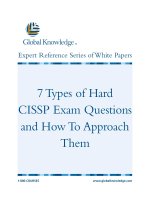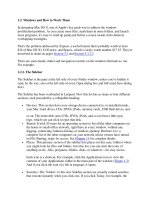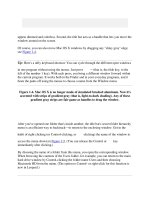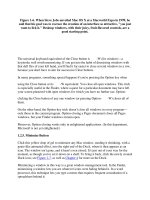English grammar 100 tragically common mistakes and how to correct them
Bạn đang xem bản rút gọn của tài liệu. Xem và tải ngay bản đầy đủ của tài liệu tại đây (1.6 MB, 165 trang )
Copyright © 2019 by Zephyros Press, Emeryville, California
No part of this publication may be reproduced, stored in a retrieval system, or
transmitted in any form or by any means, electronic, mechanical,
photocopying, recording, scanning, or otherwise, except as permitted under
Sections 107 or 108 of the 1976 United States Copyright Act, without the prior
written permission of the Publisher. Requests to the Publisher for permission
should be addressed to the Permissions Department, Zephyros Press, 6005
Shellmound Street, Suite 175, Emeryville, CA 94608.
Limit of Liability/Disclaimer of Warranty: The Publisher and the author make
no representations or warranties with respect to the accuracy or completeness
of the contents of this work and specifically disclaim all warranties, including
without limitation warranties of fitness for a particular purpose. No warranty
may be created or extended by sales or promotional materials. The advice
and strategies contained herein may not be suitable for every situation. This
work is sold with the understanding that the Publisher is not engaged in
rendering medical, legal, or other professional advice or services. If
professional assistance is required, the services of a competent professional
person should be sought. Neither the Publisher nor the author shall be liable
for damages arising herefrom. The fact that an individual, organization, or
website is referred to in this work as a citation and/or potential source of
further information does not mean that the author or the Publisher endorses
the information the individual, organization, or website may provide or
recommendations they/it may make. Further, readers should be aware that
websites listed in this work may have changed or disappeared between when
this work was written and when it is read.
For general information on our other products and services or to obtain
technical support, please contact our Customer Care Department within the
United States at (866) 744-2665, or outside the United States at (510) 2530500.
Zephyros Press publishes its books in a variety of electronic and print formats.
Some content that appears in print may not be available in electronic books,
and vice versa.
TRADEMARKS: Zephyros Press and the Zephyros Press logo are trademarks
or registered trademarks of Callisto Media Inc. and/or its affiliates, in the
United States and other countries, and may not be used without written
permission. All other trademarks are the property of their respective owners.
Zephyros Press is not associated with any product or vendor mentioned in this
book.
Interior and Cover Designer: Will Mack
Art Producer: Karen Beard
Editor: Justin Hartung
Production Editor: Andrew Yackira
Illustrations: Will Mack
Author Photo © Morgan Black
ISBN: Print 978-1-64152-373-8 | eBook 978-1-64152-374-5
This book is dedicated to those who love the
English language, who appreciate its dynamic
flexibility, and who understand that its rules are
not always set in stone.
HOW TO USE THIS WORKBOOK ON AN EBOOK
DEVICE
If you’re reading this workbook on a touch-screen device, you can
add notes and highlight text just like you would in a physical
workbook.
Some sections will prompt you to write in answers or personal
responses. It’s easy—give it a try right here: ___________.
With your finger, tap and hold for a few moments on the line above.
Depending on the device you’re using, an icon such as a magnifying
glass will appear. Lift your finger and you’ll see an options menu.
Select “Note” (or “Notes”) to add and save your own text. When
you’re done, an icon or highlighted area will remain, which you can
always return to and tap if you want to reopen and read or edit your
note.
The same tap-and-hold options menu offers “Highlight” or “Color,”
which you can select if you want to highlight a passage or “check” a
box. Experiment with it: By swiping your finger before releasing you
can select entire sentences or paragraphs. The options menu also
offers “Bookmark” for when you want quick access back to certain
pages.
This method is the same on nearly all touch-screen ebook devices,
but some have slight variations. If you’d like more information
specific to the device you’re holding in your hands, a quick online
search will yield best results.
Contents
Introduction
{ CHAPTER ONE }
Grammar Goofs
1.
Incomplete Sentences
2.
Gone and Went
3.
Phrasal Verbs
4.
Who/Whom
5.
Compound Relative Pronouns
6.
Nominative/Objective/Possessive Pronouns
7.
To/Too/Two
8.
Affect/Effect
9.
Ending a Sentence with a Preposition
10. Starting a Sentence with a Conjunction
11. Misplaced Modifiers
12. Dangling Modifiers
13. Possessive Pronouns with Gerunds
14. Dual Possession
15. Double Genitive
16. Subjunctive Mood I: If I Were . . .
17. Subjunctive Mood II: I Demand That . . .
18. May and Might
19. Get, Got, and Gotten
20. Indefinite Pronouns: Each
21. Helping Verbs: To Have
22. Helping Verbs: To Be
23. Helping Verbs: To Do
24. Reflexive Pronouns: Myself
25. Double Negatives
{ CHAPTER TWO }
Punctuation Saves Lives
26. Comma Usage
27. Comma Splice
28. Apostrophes for Pluralization
29. Hyphens
30. Capitalization
31. Quotation Marks
32. Em Dash and En Dash
33. Ellipses
34. Missing Accent Marks
35. Semicolons
36. Possessives with Names Ending in S
37. Ending a Declarative Sentence with a Question Mark
38. Colons
39. The Vocative Comma
40. Pride Capitals
41. Scare Quotes
42. Punctuation for Currency
43. Apostrophes for Holidays
44. Run-On Sentences
45. Double Spaces After a Period
{ CHAPTER THREE }
Word to the Wise
46. Sex vs. Gender
47. Weather vs. Climate
48. Like vs. Such As
49. Irregardless
50. Set vs. Sit
51. Lay vs. Lie
52. Unique
53. Will vs. Shall
54. Than vs. Then
55. Less vs. Fewer
56. Loose vs. Lose
57. Literally
58. Number and Amount
59. Could of/Should of/Would of
60. A Lot vs. Alot
61. Weather vs. Whether vs. Wether
62. Breath vs. Breathe
63. Comprise
64. Everyday vs. Every Day
65. There/They’re/Their
66. Etc. vs. Ext.
67. Historic/Historical
68. Between vs. Among
69. That/Which/Who
70. Its and It’s
71. Whose and Who’s
72. Your and You’re
73. i.e. and e.g.
74. A While and Awhile
{ CHAPTER FOUR }
High Style
75. Order of Adjectives
76. Further vs. Farther
77. Accept vs. Except
78. Redundancies
79. Clichés
80. Jargon
81. Singular “They”
82. Differences Between American English and British English
83. Contranyms
84. Gendered Professions
85. Religions and Their Adherents
86. Writing Numbers
87. “Verbing” and “Nouning”
88. Comparatives
89. Superlatives
90. Feel Good vs. Feel Well
91. Parallel Structure
92. Better Than He/Him
93. Active Voice vs. Passive Voice
94. Number Agreement
95. Orient, Orientate, and Oriental
96. Among/Amongst and While/Whilst
97. Discourse Markers
98. Demonstratives
99. Split Infinitives
100. Indeterminate Personal Pronoun Usage
Parts of Speech Cheat Sheet
Punctuation Cheat Sheet
50 Substitutions for Long-Winded Phrases
Glossary
Resources
About the Author
{ INTRODUCTION }
I once made a mistake in another language that made the national
news. I had been living in West Java (a province of Indonesia) to
study music, and I went to a music party at the provincial governor’s
house. Most people were sitting on the floor, as was the norm. I was
leaning against a wall near the musicians so I could study what they
were doing; I was also trying to be as inconspicuous as a redheaded
white girl could be in Southeast Asia. The governor invited me to sit
in a chair, as a foreign guest, but I politely declined, telling him in my
allegedly fluent Indonesian that I would rather lean against the wall .
. . or so I thought. In fact, I told him and everyone around me that I
would prefer to cry out! The two words that I used were separated by
a single letter: bersandar vs. bersangar. I can still hear not only their
raucous laughter ringing in my ears, but also my mistake repeated
over and over. If only there hadn’t been a reporter in the room!
English has so many words that are separated by a single letter.
If you have ever struggled with effect and affect, further and farther,
or than and then, I can assure you that you are in great company.
This book is your secret decoder ring: a quick and easy reference
tool that will help you remember everything from whether to double
the consonant in the past tense of cancel (spoiler: don’t) to knowing
the difference between who and whom.
I wrote this book because I am not just a college professor; I am
also a friend, colleague, mom, and person who wants all English
speakers to be able to speak and write with clarity and confidence.
Inside this book, you’ll find 100 of the most common mistakes in
grammar, punctuation, vocabulary, and style. My goal is for you to be
(metaphorically, at least) running toward clarity, rather than running
from murkiness. Leave your tragic mistakes behind and, with
apologies to William Shakespeare, let slip the dogs of grammar!
{ CHAPTER ONE }
Grammar Goofs
Most of us learned proper grammar when we were young. But,
over the years, mistakes turn into bad habits, which turn into
fodder for mockery from the grammar sticklers in our lives.
These errors are among the most common you’ll find.
1. Incomplete Sentences
It’s important to remember: “When a sentence is incomplete.” Um,
what? When a sentence is incomplete, no one knows what you’re
talking about. A half-finished sentence makes for a half-baked
thought.
INCORRECT
• Whether the stolen shirt was in her purse.
• As if they hadn’t flirted already!
• No way he could eat any more.
CORRECT
Most incomplete sentences are linked to a sentence either before or
after the incomplete phrase in question. Adding “The security guard
wanted to see” to “whether the stolen shirt was in her purse”
transforms an incomplete sentence about a stolen shirt into a
perfectly understandable complete sentence.
MEMORY TIP
Every complete sentence needs a subject—the person, place, thing,
or idea that is doing or being something—and a predicate (which
finishes an idea about the subject).
2. Gone and Went
Go is one of the 200 or so irregular verbs that can make Englishlanguage learners tear out their hair. It’s simple enough to use “I go”
or “he goes” correctly, but mastering the various tenses can be a
struggle for even native English speakers.
INCORRECT
• We’ve went to work every day this year.
• Their cousin gone home.
• My granddad said that he gone fishing.
CORRECT
The irregular verb to go uses simple past tense—went—to indicate
something that may still be happening. Where is he? He went to the
store. (Maybe he’s still there!) When you include a variant of the
auxiliary verb to have, it changes into the perfect tense. Using have
means the action is complete: Their cousin has gone home. (He isn’t
returning!) You never have went anywhere, though.
MEMORY TIP
Consider these sentences: “I went shopping” and “She went to
school.” Are they permanent? They are not. At some point she’ll be
coming home from school. No one writes a sad country song titled
“She Went”; they all say that “she’s gone.” In the words of the late
country singer Troy Gentry’s song “Gone,” when someone has gone,
they are “like all the good things that ain’t never comin’ back.” Note
that last phrase; it’s over.
3. Phrasal Verbs
You use phrasal verbs all the time! Many are made up of two-word
phrases with a verb and a preposition (try out) and some contain
three words (look forward to). Even though they’re very common, it’s
still easy to make a mistake when using them in a sentence.
INCORRECT
• We sat down with the bagels and divided up them.
• I’m looking forward to see you soon.
CORRECT
The two most common errors are misplaced pronouns (as in divided
up them), and neglecting to use an –ing verb in a three-word phrase.
Keep the constituent parts of a phrasal verb together so that you
divide up the bagels. In the common three-word phrases, don’t forget
the –ing at the end of the verb. I’m looking forward to seeing you
soon.
MORE TO KNOW
Some three-word phrasal verbs are transitive and need a noun to be
complete. You can get away with murder, look down on hoi polloi,
and take care of your aging relative.
4. Who/Whom
People seem to be terrified of whom, and for good reason. Most of
us never learned how to use whom because—and this is a secret—
our teachers didn’t understand it either. Fret no more! You may now
use whom with confidence.
INCORRECT
• Whom does this belong to?
• Ask not for who the bell tolls.
• Let me know whom said that; I can’t remember whom it was.
CORRECT
The heart of the matter is whether the word is the subject or object of
the sentence. When you’re working with the subject, use who. Who
said it? She said it! (As the subject of the sentence, you could also
use her name instead of who. Hana said it!) If the word in question is
the object of the sentence, use whom. This belongs to whom? It
belongs to him.
MEMORY TIP
Wondering if you’ve used the correct word? If you can replace the
word with “he” or “she,” the proper choice is who. If the replacement
can be “her” or “him,” whom is the correct usage.
QUIZ
What order should who and whom appear in the following
sentences?
---------- says I don’t know grammar? ---------- should I mark up
with my red pen?
He/she = who (subject), so “who says” is correct. Him/her = whom
(object), so “whom should I” is correct. “He says” and “I should mark
him up” answer the questions.
5. Compound Relative Pronouns
The next time a teenager rolls their eyes at you, says “Whatever!”
and stomps away, lure them back with your grammatical brilliance by
saying, “Oh, honey! You just correctly used a compound relative
pronoun!” So many people are confused by this concept, but it’s
easy to use the proper word.
INCORRECT
• Go with those people, whichever they are headed.
• Did you tell them whoever you are?
CORRECT
Whatever, whichever, wherever, whoever, and whomever are all
compound relative pronouns. They join one clause to another, as in
“Whatever candy you choose, I won’t be angry,” “Go with those
people, wherever they are headed,” and “You may dance with
whomever you wish.” These pronouns are inherently open and
inviting of various options, which is, after all, what we all want in life.
MORE TO KNOW
As pronouns, these words serve subjects or objects: “Whoever
[subject] left their dishes on the table needs to return and clean up.”
“I will go with whomever [object].” They are compounds because
they add –ever to what, who, and other such question words:
“Whatever do you want at this hour?” They also act as conjunctions
because they join phrases: “I will eat whatever you’re eating.”
6. Nominative/Objective/ Possessive
Pronouns
This common mistake is especially tricky when there are two
pronouns. Once you learn how to use the proper pronoun, you’ll hear
mistakes all around you. Luckily, there’s an easy trick to ensure
you’ve chosen the right word.
INCORRECT
• Bring that to him and I.
• She cats don’t belong to my.
CORRECT
The difficulty most often arises with more than one object pronoun.
“Bring that to him and me” is right; many people will incorrectly say
“him and I.” “I visited him and her” is correct, while “I visited he and
she” is incorrect. To get it right every time, remove one of the two
pronouns: “Bring that to him” (correct) and “Bring that to I”
(incorrect). That second one sounds so wrong that you will correct
yourself automatically: “Bring that to him and me.”
MORE TO KNOW
Personal pronouns take three different forms: nominative (I),
objective (me), and possessive (both my and mine, all mine). I am
eating this chocolate (I am the subject). The chocolate belongs to me
(the object is me). It is mine (a self-sufficient possessive pronoun).
The subject pronouns include I, you, he, she, it, we, you, and they.
Object pronouns include me, you, him, her, it, us, you, and them.
Possessive pronouns include the dependent category of my, your,
his, her, its, our, your, and their; they each take an object, as in my
dog. The independent category includes mine, yours, his, hers, its,
ours, yours, and theirs. Notice that none of the possessive pronouns
use apostrophes.
QUIZ
Which pronouns would you use, and in what order?
---------- sat there with ----------; ---------- didn’t realize that this
table was ----------.
Choose your favorite pronouns from the lists above! [Subject
pronoun] sat there with [object pronoun]; [plural subject pronoun]
didn’t realize that this table was [possessive pronoun]. For example,
I sat there with him; we didn’t realize that this table was hers.
7. To/Too/Two
The main reason we confuse these three words is because they are
homophones. They sound the same, so our overloaded minds mash
them together into one word: to. It makes grammarians want to
scream—two times!
INCORRECT
• You’re to funny.
• We were going two buy some more popcorn today.
• They like cake so they bought too of them.
CORRECT
Everyone uses these words correctly in speech because they sound
the same. The preposition to is used to indicate that one is moving
“for the purpose of” or “in the direction of.” We were going to buy
some popcorn; my cat is going to the window. Too means “in excess”
or “also.” I ate too many cookies this year and he did, too.
FUN FACT
Anything involving two uses tw somewhere in the word: between,
twice, twins, twenty, intertwine, and more.
8. Affect/Effect
Of all the word pairs separated by a single vowel, this pair is the
worst for native speakers and language learners alike. Between the
two words, there are four different meanings: Affect is both a verb (to
influence) and a noun (emotional expression), and effect is both a
verb (to make happen) and a noun (impact).
INCORRECT
• Ooh, I love those sound affects.
• Their son didn’t consider whether eating that much candy might
effect him.
• It is time for us all to affect change in our own lives.
CORRECT
About 80 percent of the time, you can trust that affect is a verb.
“Eating a lot of candy might affect you. It affected me greatly.”
Similarly, effect is usually a noun. If you love a particular sound effect
such as a cowbell, that effect is a single item—a noun (a cowbell, in
this case). An effect is an impact: “Wow! That cowbell had quite the
effect on the audience!”
MORE TO KNOW
In spite of the tempting rule that affect = verb and effect = noun,
there are exceptions. Affect is also a noun, and effect is also a verb.
Affect (noun) is used in psychology, and refers to emotional display.
People with “flat affect” appear emotionless, even if they aren’t. To
effect (verb) is to bring about or make happen. You, too, can effect
change in your life.
QUIZ
In what order should you use affect and effect in the following
sentence?
The beautiful lighting ---------- in the clinic ---------- ed the
patients greatly; they made me wish to ---------- changes in our









